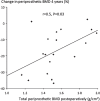Good stability but high periprosthetic bone mineral loss and late-occurring periprosthetic fractures with use of uncemented tapered femoral stems in patients with a femoral neck fracture
- PMID: 24954490
- PMCID: PMC4105771
- DOI: 10.3109/17453674.2014.931195
Good stability but high periprosthetic bone mineral loss and late-occurring periprosthetic fractures with use of uncemented tapered femoral stems in patients with a femoral neck fracture
Abstract
Background and purpose: We previously evaluated a new uncemented femoral stem designed for elderly patients with a femoral neck fracture and found stable implant fixation and good clinical results up to 2 years postoperatively, despite substantial periprosthetic bone mineral loss. We now present the medium-term follow-up results from this study.
Patients and methods: In this observational prospective cohort study, we included 50 patients (mean age 81 (70-92) years) with a femoral neck fracture. All patients underwent surgery with a cemented cup and an uncemented stem specifically designed for fracture treatment. Outcome variables were migration of the stem measured with radiostereometry (RSA) and periprosthetic change in bone mineral density (BMD), measured with dual-energy X-ray absorptiometry (DXA). Hip function and health-related quality of life were assessed using the Harris hip score (HHS) and the EuroQol-5D (EQ-5D). DXA and RSA data were collected at regular intervals up to 4 years, and data concerning reoperations and hip-related complications were collected during a mean follow-up time of 5 (0.2-7.5) years.
Results: At 5 years, 19 patients had either passed away or were unavailable for further participation and 31 could be followed up. Of the original 50 patients, 6 patients had suffered a periprosthetic fracture, all of them sustained after the 2-year follow-up. In 19 patients, we obtained complete RSA and DXA data and no component had migrated after the 2-year follow-up. We also found a continuous total periprosthetic bone loss amounting to a median of -19% (-39 to 2). No changes in HHS or EQ-5D were observed during the follow-up period.
Interpretation: In this medium-term follow-up, the stem remained firmly fixed in bone despite considerable periprosthetic bone mineral loss. However, this bone loss might explain the high number of late-occurring periprosthetic fractures. Based on these results, we would not recommend uncemented femoral stems for the treatment of femoral neck fractures in the elderly.
Figures




Similar articles
-
Cemented versus uncemented hemiarthroplasty for displaced femoral neck fractures: 5-year followup of a randomized trial.Clin Orthop Relat Res. 2014 Apr;472(4):1291-9. doi: 10.1007/s11999-013-3308-9. Epub 2013 Oct 1. Clin Orthop Relat Res. 2014. PMID: 24081667 Free PMC article. Clinical Trial.
-
Higher periprosthetic fracture rate associated with use of modern uncemented stems compared to cemented stems in femoral neck fractures.Hip Int. 2019 Mar;29(2):177-183. doi: 10.1177/1120700018772291. Epub 2018 Apr 23. Hip Int. 2019. PMID: 29682992
-
Outcomes and survival of a modern dual mobility cup and uncemented collared stem in displaced femoral neck fractures at a minimum 5-year follow-up.Orthop Traumatol Surg Res. 2022 Feb;108(1):103164. doi: 10.1016/j.otsr.2021.103164. Epub 2021 Dec 1. Orthop Traumatol Surg Res. 2022. PMID: 34863956
-
Periprosthetic femoral bone loss in total hip arthroplasty: systematic analysis of the effect of stem design.Hip Int. 2017 Feb 21;27(1):26-34. doi: 10.5301/hipint.5000413. Epub 2016 Aug 3. Hip Int. 2017. PMID: 27515762 Review.
-
New polymer materials in total hip arthroplasty. Evaluation with radiostereometry, bone densitometry, radiography and clinical parameters.Acta Orthop Suppl. 2005 Feb;76(315):3-82. Acta Orthop Suppl. 2005. PMID: 15790289 Review.
Cited by
-
More complications with uncemented than cemented femoral stems in total hip replacement for displaced femoral neck fractures in the elderly.Acta Orthop. 2017 Apr;88(2):145-151. doi: 10.1080/17453674.2016.1262687. Epub 2016 Dec 14. Acta Orthop. 2017. PMID: 27967333 Free PMC article. Clinical Trial.
-
Low rates of all-cause revision in displaced subcapital femoral neck fractures treated with hip hemiarthroplasty - a retrospective review of 4516 patients from a single institute.BMC Musculoskelet Disord. 2020 Oct 22;21(1):700. doi: 10.1186/s12891-020-03725-0. BMC Musculoskelet Disord. 2020. PMID: 33092551 Free PMC article.
-
Bone Loss Following Cementless Hemiarthroplasty for the Treatment of Femoral Neck Fracture.Indian J Orthop. 2020 Jan 31;54(4):454-462. doi: 10.1007/s43465-019-00009-1. eCollection 2020 Jul. Indian J Orthop. 2020. PMID: 32549960 Free PMC article.
-
Fixation, sex, and age: highest risk of revision for uncemented stems in elderly women - data from 66,995 primary total hip arthroplasties in the Norwegian Arthroplasty Register.Acta Orthop. 2020 Feb;91(1):33-41. doi: 10.1080/17453674.2019.1682851. Epub 2019 Oct 30. Acta Orthop. 2020. PMID: 31663413 Free PMC article.
-
No effect of risedronate on femoral periprosthetic bone loss following total hip arthroplasty. A 4-year follow-up of 61 patients in a double-blind, randomized placebo-controlled trial.Acta Orthop. 2015;86(5):569-74. doi: 10.3109/17453674.2015.1041846. Acta Orthop. 2015. PMID: 25885280 Free PMC article. Clinical Trial.
References
-
- Alm JJ, Makinen TJ, Lankinen P, Moritz N, Vahlberg T, Aro HT. Female patients with low systemic BMD are prone to bone loss in Gruen zo... . Acta Orthop. 2009;80(5):531–7. - PMC - PubMed
-
- Ang KC, Das De S, Goh JC, Low SL, Bose K. Periprosthetic bone remodelling after cementless total hip replacement. ... . J Bone Joint Surg (Br) 1997;79(4):675–9. - PubMed
-
- Boden H, Salemyr M, Skoldenberg O, Ahl T, Adolphson P. Total hip arthroplasty with an uncemented hydroxyapatite-coated tapered ... . J Orthop Sci. 2006a;11(2):175–9. - PubMed
-
- Boden HS, Skoldenberg OG, Salemyr MO, Lundberg HJ, Adolphson PY. Continuous bone loss around a tapered uncemented femoral stem: a long-te... . Acta Orthop. 2006b;77(6):877–85. - PubMed
-
- Brodner W, Bitzan P, Lomoschitz F, Krepler P, Jankovsky R, Lehr S, et al. Changes in bone mineral density in the proximal femur after cementless t... . J Bone Joint Surg (Br) 2004;86(1):20–6. - PubMed
Publication types
MeSH terms
Substances
LinkOut - more resources
Full Text Sources
Other Literature Sources
Medical
